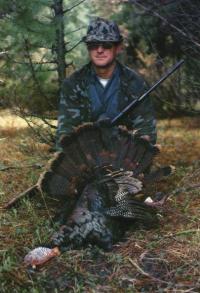
Serving the Vermont Champlain Valley Area for 45 Years
Main SectionsFront Page SportsValley VitalsIt's in the StarsStarwiseArchivesLinksAbout The VoiceContact Us |
Sharing Memories With John Campbell A Lifetime of Hunting & Wildlife Management
Tuesday November 16, 2010 By Larry Johnson A few days ago I was fortunate enough to reconnect with someone whom I hadn’t seen or spoken to in over fifty years. The irony of the situation is that John Campbell and his wife June live only a short distance from where I have spent much of the past half century. Fifty-two years ago John and I worked together, for one summer, at the Dead Creek Wildlife Management Refuge in Addison. We were both seasonal workers. At the end of the summer I went back to high school but John continued working at Dead Creek and in 1960 became a full-time construction worker, helping to maintain buildings, roads, fences and dealing with the multitude of construction and mechanical details that go into running a public facility the size of Dead Creek, an area that includes about 2500 acres spanning parts of Panton, Addison and Bridport. In 1970, John became Refuge Manager and remained in charge until 1999 when he retired. “I loved my job,” John told me, “but I retired because I wanted to do something different. You know, you can only flip so many burgers before you want to try something else.” During his tenure at Dead Creek, John’s many hats varied greatly with the seasons and with the necessary changes that came about. He was responsible for laying out various projects in the Refuge, from pouring concrete for building foundations and culvert headers to constructing and maintaining Wood Duck boxes. In the winter, for instance, much time was spent just cleaning out existing nesting boxes and counting the residual egg membranes in order to compare it to summer hatch. Each box set atop a white cedar pole, that had to be raccoon and snake-proofed, in order to keep the creatures from eating the eggs as well as the young birds. Occasionally the boxes had to be moved out into deeper water in order to prevent them from being invaded by unwelcome guest. John admitted he loved the outdoor work best, whether it was mowing roadsides, putting up highway signs, or keeping waterways open and free of cattails, so that weed seeds and sedges could grow and provide feed for the waterfowl. On good days in the winter he would be out on the ice of Dead Creek. This was where he was the happiest, working in the outdoors. On bad days he would be in the shop building boxes or maintaining equipment. During deer season the Refuge became a deer weighing station, and during the spring there was the netting and banding of the migrating flocks. Identification of sex, age and band numbers were noted and sent to the Federal Banding Institution in Washington, D.C., where the information was collated and eventually used to make policy pertaining to waterfowl maintenance. One major success that spanned John’s time at Dead Creek was the Canada Goose project. A 70 acre enclosure, with a predator proof fence around it, housed around 50 original geese, all of whom had been immobilized by having their wings clipped. These geese were the starter flock. Wild geese, seeing the grounded geese, would drop into the enclosure and mate with them. Eventually this increased the number of geese in the fall and spring exponentially. The same thing happened with the Snow Geese. They began stopping by and their numbers topped out at between 15,000 to 20,000 birds. Unfortunately they have been greatly reduced because of a diminished food supply. It seems that farmers in the area are plowing up their fields earlier in the fall, and subsequently the leftover corn is being turned under before the birds arrive. According to John, the lighter soils in parts of New York are more inviting as a food supply because the fields are plowed later. In 1999, when John retired from Dead Creek, he was determined to spend more time engaged in his passion—hunting; and he has divided his energy and his time working in the summer for Briggs Construction in Addison, operating a bulldozer and a round pointed shovel, as he put it, to spending the autumn months in the woods, often with his sons Chris and Eric, grandsons and nephews, and often in other parts of the country. When at home, he has Snake Mountain in his backyard, but he has bow hunted in Massachusetts, spent 13 seasons in Maine, hunted along the Missouri River in Montana where he shot two mule deer and once killed an elk in Colorado with a black powder musket. All-in-all his lifetime deer kill is somewhere between 35 and 40. He can’t quite remember. John’s greatest joy, other than hunting, is teaching others to hunt, namely his grandsons and nephews. At 72 he is still hail and hearty and, although he says he has slowed down some, I believe he has a lot more mountains to climb and rivers to cross.
|
AdvertisementsSearch our Archives |
Agricultural Weather Forecast:

© 2006-18 The Valley Voice • 656 Exchange St., Middlebury, VT 05753 • 802-388-6366 • 802-388-6368 (fax)
Valleywides: [email protected] • Classifieds: [email protected] • Info: [email protected]

 Printer Friendly
Printer Friendly